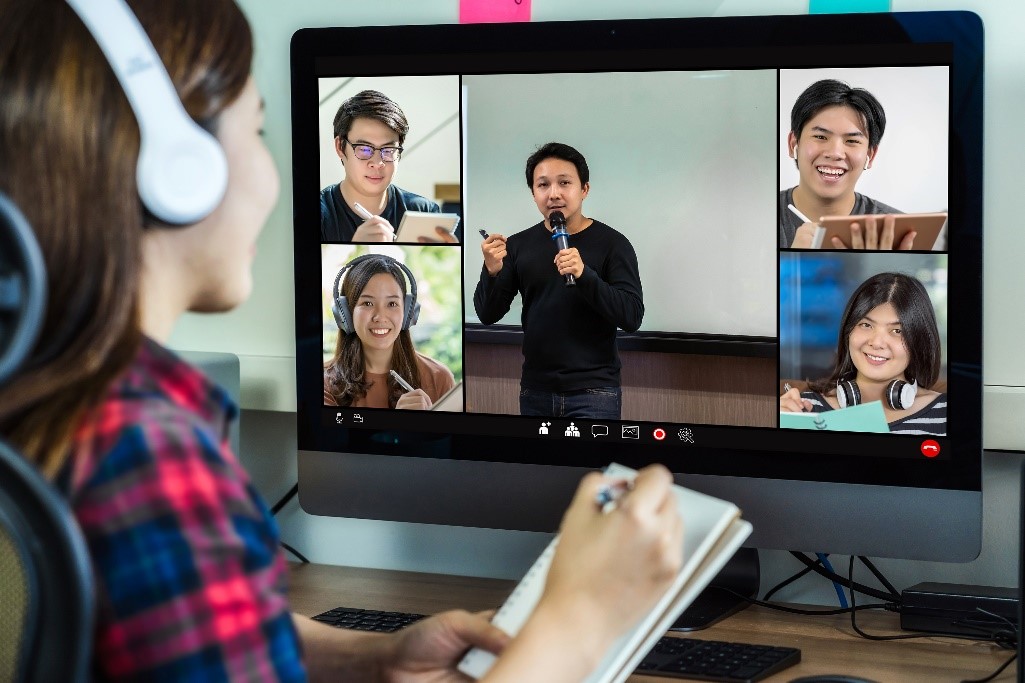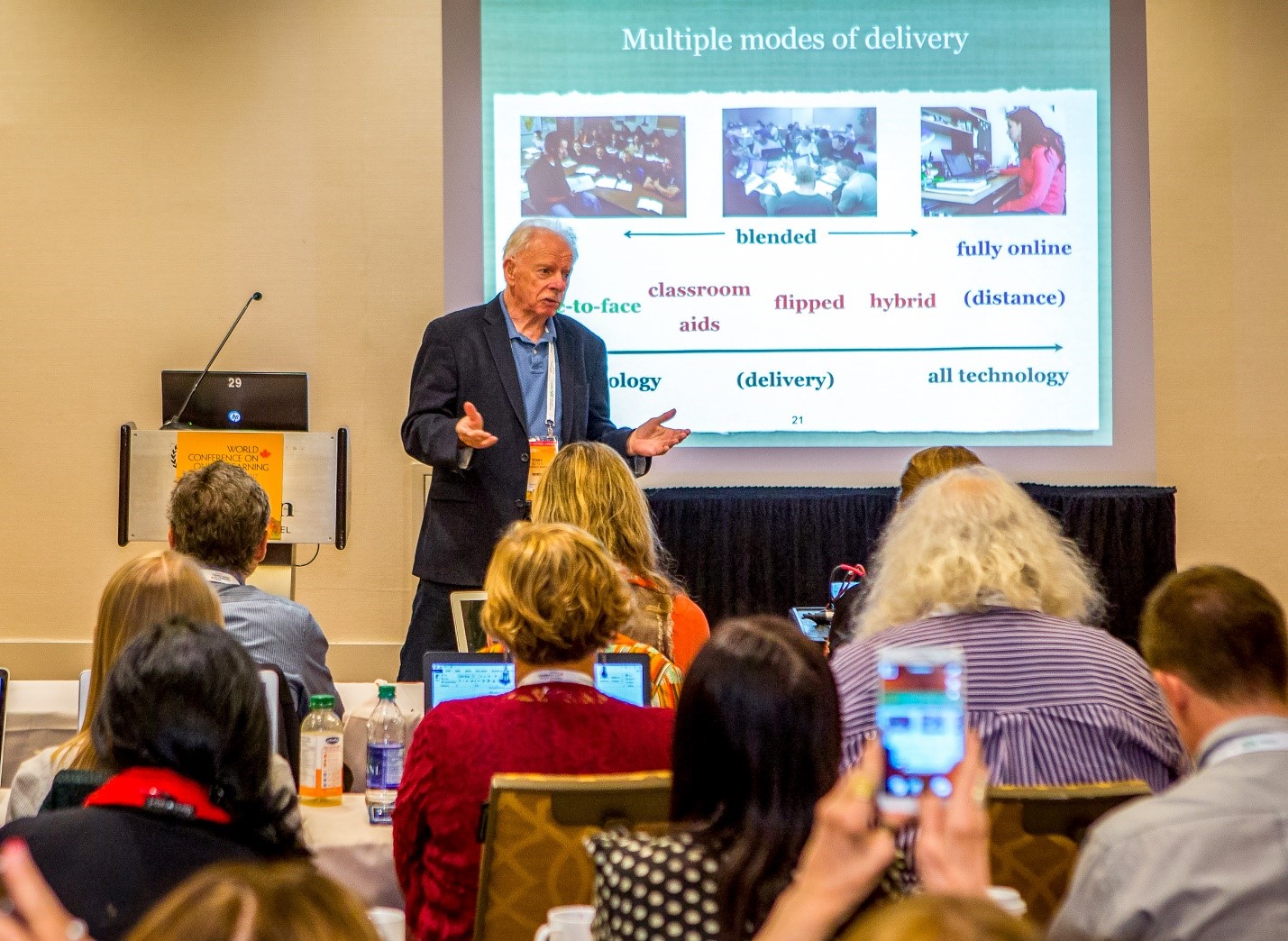 by Dr. Tony Bates
by Dr. Tony Bates
Contact North | Contact Nord
Research Associate
2020: Resilience and adaptability
“Canada responded amazingly well to the challenge of adapting to an existential threat to its post-secondary education system. The system proved its resilience.”
2020 has been a tough year, for both students and instructors. However, the post-secondary system (students, administrators, faculty, and instructors) showed amazing resilience and adaptability. Much was learned, about both the strengths and weaknesses of online and classroom learning.
The shock of nearly all colleges and universities moving their classes to emergency online learning resulted in several lessons that apply well into the future. As we move into planning for 2021-2022 and a post-pandemic college/university experience, what are the lessons we can take from the 2020 experience? What do we need to learn and unlearn?
Blended learning is the future
Blended learning looks to be the future of teaching in Canadian post-secondary education, and we are seeing many more instructors learning how to develop and manage this method of teaching as a result of COVID-19. Support from administrators and particularly from centres for teaching and learning was essential.
As we gradually come out of COVID-19, much will stay the same as before, but probably much more will change permanently.
How do I know this? Since March 2020, I have been tracking research on the impact of emergency online learning (see here for a list of studies) and working with several institutions as they pivoted to online delivery.
There are many possible lessons to be learned, but here is a selection that affect all students, instructors and administrators in Ontario colleges and universities.

“…in blended learning, student performance improves over both face-to-face and fully online learning.”
Before COVID-19, research indicated that in Canada, faculty resistance was a main barrier to increased online learning. In March and April 2020, however, all instructors had to move to at least emergency online learning. That was a cathartic moment.
The experience clearly varied. Some instructors took to it like a duck to water. Some hated it and still do. But the majority, who reluctantly did what they had to and were not completely happy with it, also learned there is much that can be taught online just as well if not better than on campus.
And many learned that online teaching, especially working from home, can be very satisfying, as well as convenient.
In fact, before 2020, fully online learning was increasing steadily at a rate of 10 per cent a year in Canadian colleges and universities, until in 2018 it constituted 10 per cent of all credit course enrolments.
I expect that after COVID-19, there will be an up-tick overall in the number of fully online courses and enrolments in these courses. Courses successfully moved online during COVID-19 are likely to stay online if there is sufficient demand from students.
However, we know that fully online courses appeal more to older, working students, and hence more to post-graduate or continuing education students, or students in their final undergraduate year.
I anticipate then that fully online learning will not increase to more than 20-25% of all credit course enrolments.
In contrast, though, I see a rapid and massive move to blended learning, where students mix campus-based and online learning. This of course is already happening informally since students choose to do a lot of studying online at home as well as on-campus.
Deliberate design
The difference is I see instructors deliberately designing courses to exploit the comparative benefits of both online and face-to-face teaching, and in particular, the asynchronous benefits of online learning.
Research shows that in blended learning, student performance improves over both face-to-face and fully online learning. The reason given is students spend more time on task (i.e. work harder) in blended learning courses.
Thus, I am optimistic we will see a considerable change in modes of delivery that will benefit both students and instructors as a result of COVID-19.

“The main lesson is we need to increase support for Instructors in all forms of teaching: face-to-face, blended and online.”
When institutions had to switch to emergency online learning in Spring 2020, most instructors were totally unprepared. However, especially following the immediate and short-term implementation of emergency online learning in Spring 2020, there was a tremendous response from both instructors and staff in centres for teaching and learning.
Many instructors sought and found help in how to teach online, not only from their centres for teaching and learning, but also from online sources such as teachonline.ca.
My blog post, Advice to those about to teach online because of the coronavirus, received more than 55,000 hits, mostly in March 2020, far more than any of my other posts over the past 10 years.
Contact North | Contact Nord’s webinar series providing training to faculty also experienced record attendance.
The support from centres for teaching and learning focused on three issues in particular:
- Online course design
- Alternative approaches to teaching other than the lecture method (with an emphasis on active online learning)
- Training in the use of key tools, such as learning management systems, and videoconferencing technologies such as Zoom
Many instructors were imaginative in thinking of new ways to engage students online (see Lesson 4 below for examples).
Increased support essential
The main lesson is we need to increase support for instructors in all forms of teaching: face-to-face, blended and online. This means more support staff in centres for teaching and learning: not only expert course designers, but also media specialists with a particular emphasis on student engagement.
However, there is a scaling issue.
Previously, centres for teaching and learning could cope with directly supporting about 10 per cent of all instructors in a year, often on a one-on-one basis. If, as I believe, all courses in the future will be either blended or fully online, alternative strategies for teaching support are needed to support all instructors all the time.
To provide this support, we need to:
- Build online resources related to teaching online that instructors can access as needed, such as how to make a good educational video
- Offer short courses on blended or online course design that are themselves blended or online
- Develop and share open educational resources for faculty development and training to achieve economies of scale across the system
- Invite students to provide help and feedback, such as technical support in video or games design and production
One of the benefits will be that instructors are not only more skillful in teaching, but there will be greater institutional resilience to deal with external shocks such as pandemics.

“We know how to do quality online and blended learning, but we can also learn from emergency online learning.”
“We still need to learn about the conditions in which synchronous learning works best, but we need to avoid simple conclusions...”
There was a lot of head shaking about emergency online learning, with many experts trying to “distance” quality online learning from emergency online learning.
The main criticism is using Zoom to deliver lectures is not the most effective way to teach online. These criticisms are based on more than 20 years’ experience in identifying what works well — and what doesn’t — in online learning. However, I’d like to make two important points.
First, many best practices were developed through asynchronous online learning, with the learning management system (LMS) as the key tool. Asynchronous tools such as the LMS enable students to learn at any time, anywhere.
The LMS was the original technology of choice for online learning because its main benefit was providing better access.
Asynchronous vs synchronous
Asynchronous online learning was the only way many people with jobs or families could study. Going to a campus regularly was just not possible, but these students could structure their learning around other commitments.
We know, too, that students generally learn better asynchronously, because they have not only more flexibility, but spend more time on task. It is on the basis of such asynchronous learning that best practices in online learning were developed.
Second, video streaming was not technically feasible until a few years ago, at least at a manageable cost. But along came Zoom and other streaming technologies, and so in Spring 2020, synchronous video was seized upon by many instructors because they could move to it instantly, with little adaptation of their existing teaching methods.
User-friendly system
Since it takes considerably less time to learn how to use a very user-friendly system such as Zoom than to learn about different teaching methods — or a learning management system — this was obviously going to be the approach of choice for most instructors without prior online teaching experience, when everything had to be moved online in less than two weeks.
This resulted in many online learning experts throwing their hands in the air and claiming this wasn’t “proper” online learning. As a result, much of summer 2020 was spent trying to persuade instructors to move away from streaming lectures for the Fall 2020 semester.
What prior experts in online learning, including myself, were slow to acknowledge is there are also some pedagogical benefits in synchronous online learning, especially for full-time students who now can no longer access the campus.
Not having to choose
In reality, it is not a choice between Zoom or Moodle, for instance, but deciding the advantages or affordances of each, and then using them appropriately.
Indeed, even before COVID-19, Zoom and similar technologies were increasingly used for online learning.
We still need to learn about the conditions in which synchronous learning works best, but we need to avoid simple conclusions that synchronous or asynchronous, face-to-face or online, are intrinsically better or worse.
We need to identify the conditions in which each delivery method works best, and the response to COVID-19 is providing the opportunity to identify these conditions.
The end of lecture streaming?
I expect that streaming live 60-minute lectures with little student interaction will remain a poor way to teach online.
We are finding more useful ways to use synchronous technologies, such as virtual small group discussions, using the Zoom break-out facility, with reporting back into the main class, although I am expecting other roles for online synchronous learning to be developed.

“...a reassessment of assessment itself is long overdue in post-secondary education.”
The need to avoid attending campus for exams during COVID-19 forced a re-examination of our methods of assessment. In fact, a re-assessment of assessment itself is long overdue in postsecondary education.
The main initial focus during COVID-19 was on invigilation.
How can you be sure the person taking the exam is actually the student enrolled? There are various technological answers to this question, such as cameras and “fingerprints” derived from tracking keyboards or digital thumb recognition.
However, these do not deal with the real issue: Are we using the most appropriate design of assessment for today’s students? What needs to be challenged is whether having students do a paper-and-pencil test for up to three hours is an appropriate way to assess learning in the 21st century.
Assessing level of skill
Such paper-and-pencil tests can work well for measuring comprehension and understanding at a particular time, but the focus now should be on assessing not just a particular skill, such as critical thinking, but the level of skill and its development over the period of a course or program.
This is a far better way to determine the potential of a student.
A set exam at a set time merely measures that student at the time of the exam. We all know the experience of cramming for an exam, and forgetting almost everything six months later. But if an intellectual skill was taught well, that stays with you, and indeed continues to develop, well after a formal period of study.
Trackable traces
We can learn a lot about assessment from past experience of online learning programs. Online learning lends itself to continuous or formative assessment rather than terminal or summative assessment because a well-designed online course leaves trackable traces of what students are learning and doing (I am referring to asynchronous courses using an LMS).
You can actually track individual students’ day-by-day progress as they work through the course. This became an increasing focus of conversations about assessment as the Fall 2020 term approached and it was clear online would remain the dominant form of teaching for colleges and universities.
Discussion forums
Students’ contributions to discussion forums can be reviewed. Students can be given a course e-portfolio, where they can record their notes or reviews of reading, and track their contributions to assignments.
These can be both private (for their own use) or for assessment purposes, in which case they are reviewable by the instructor. Students can be given group project work, and using the discussion forum space in a learning management system, individual students’ contributions to the project can be assessed.
This is a particularly useful way to track and assess students’ development of intellectual skills, such as textual communication, critical thinking or independent learning. Even with a return to on-campus classes, student work can still be done online and tracked. This also spreads out the assessment process, avoiding the intense marking of many papers over a few days.
For these reasons, a re-assessment of assessment may be one of the more fruitful outcomes of the move to online learning due to COVID-19.

“…we need to take a more holistic approach, reward innovation in teaching, build it into program planning, evaluate it, and properly resource it.
Instructors responded in many different ways to the challenge of online teaching. Some merely moved their classroom lectures online through video streaming, which is neither innovative nor likely to be effective.
Others followed advice from instructional designers and tried to incorporate previously identified best practices from earlier applications. This may be more effective, but it is not really innovative, by definition.
A smaller number tried something completely different.
For instance, one professor created a virtual student lounge, using the popular game Minecraft, with avatars that enable students to have a place to connect with each other. Another created a virtual newsroom where students play the role of the managing editor in a fictional newsroom, where they address various editorial situations.
However, to what extent will innovations spread beyond an individual instructor, resulting in changes to teaching across a subject discipline, for instance?
Is innovation always effective?
And although the teaching may be new or innovative, is it effective? What kind of learning results? Is it the same or different from traditional methods, and if different is it better? In other words, innovative teaching needs to be carefully evaluated.
If we want innovation to work, in the sense that it leads to better learning or outcomes, and spreads beyond one or two enthusiastic individuals, we need to look at what encourages or sustains innovation in organizations.
In particular, we need to look at what strategies administrators can use to encourage successful and widespread innovation in teaching.
Above all, we need to think very concretely about what teaching and learning could or should look like in the future. Our reach should exceed our grasp, driven by our assessment of the needs of students in the 21st century, and not by the existing institutional requirements they must fit into. The best place to develop such a vision is at the program level.
A holistic approach
At a senior management level, it is essential to think holistically about teaching, innovation and the culture of the organization.
Without knowing where innovative teaching fits in the big picture, it will be difficult if not impossible to support and expand innovative teaching beyond the individual or instructor.
This means looking at what we want to achieve in teaching and learning.
For instance, do we want more flexibility for students in how courses are delivered? Are we trying to reach more diverse or disadvantaged students? Do we want students to develop high-level intellectual skills?
Without such a framework or set of criteria, it is difficult to decide whether to support or adopt an innovation. On the other hand, innovative teaching can lead to identifying new or better goals.
Virtual reality
For instance, one science instructor, experimenting with virtual reality, found his efforts resulted in better intuitive thinking among his research students, enabling them to create better hypotheses and avenues of research.
As a result of innovation, therefore, it may be necessary to reexamine our academic goals, although is difficult to do if the institution, academic department or program does not have clear strategies or goals for teaching and learning.
We need innovation in how we deliver and teach, in how we support learners, how we prepare instructors, and above all how we use technology for teaching.
As important and valuable as it is for an individual instructor to try something new in the classroom, we need to be more ambitious and look at innovation at the program and institutional level. Pockets of innovation are all well and good, but key questions at the program level also must be addressed, such as:
- Do course outcomes address the competency expectations of a professional licensing body?
- Do teaching methods reinforce best practices in the field of study across all courses?
- Does the delivery reflect best practices in professional ethics and conduct?
- Do learning outcomes adequately lay the foundation for the next learning experience so students not only succeed but excel?
- Do students increase their level of intellectual skills such as critical thinking and problem-solving as they progress through a program?
- Does the program provide a basis for lifelong development of such skills after graduation?
If our colleges and universities are to remain relevant in the 21st century, it is the whole institution that needs to change. For this to happen, we need to take a more holistic approach, reward innovation in teaching, build it into program planning, evaluate it, and properly resource it.
Our institutions may be well-meaning and at a strategic level may support the idea of innovation, but we need to be much more professional and hard-nosed about making innovation in teaching and learning work.

“...what is needed is a broader national effort to create high-quality, open digital media that can be shared across most of the common courses...”
The whole world seemed to rush into video transmission of class-room teaching: lecturing, mainly. The technology enabled instructors to pivot almost immediately to online learning, but in Spring 2020, there was no time to consider alternative uses of media.
The issue is not so much the use of synchronous technologies but rather issues with large lecture classes. This is not new.
In 1975, Donald Bligh first published “What’s the Use of Lectures?”, which provided detailed research evidence on successful and unsuccessful lecturing. Some key findings:
- Content delivery and comprehension are emphasized at the expense of higher-level skills development such as analysis or critical thinking
- Students learn less when they are not interacting with the instructor, each other or learning materials; in other words, research indicated they lose focus after 10 or 15 minutes of a talking head.
But I have another problem with the use of synchronous video for relaying lectures: the unique pedagogical characteristics of video are not being effectively exploited.
Streaming as substitute
Zoom or similar streaming services is generally a substitution for classroom teaching. Ruben Puentedura, a Massachusetts-based consultant who focuses on transformative applications of information technologies to education, argued that media are best used to “transform” teaching, doing something that could NOT be done in a classroom.
There is a great deal of research showing that audio, video and computing can do many things better than what can be done in a classroom or even a physical or wet lab. There are many possibilities:
- Video can be used to show experiments that are too dangerous or too difficult for students to do on their own or even in a lab
- Audio, combined with text, can talk students through difficult formulae, arguments or evidence (the Khan Academy is a good example)
- Video or computer games can be used to help students practise decision-making skills in a safe environment;
- Computer simulations can enable students to understand intuitively complex relationships
- Digital media also have the advantage of being asynchronous, available at any time and any place, enabling students to practise or spend more time on task
One reason media was underused in teaching is the cost and effort of creating learning materials. This is changing, however.
Instructors are increasingly using their mobile phones to record experiments or display scarce resources such as animal parts in veterinary science, or to record everyday events that illustrate key concepts.
Some are using or adapting off-the-shelf mobile apps to enable students to do field work without direct supervision.
Open resources are vital
This is where open educational resources become important.
During COVID-19, instructors increasingly found free material on the Internet, licensed for educational use, which they can incorporate at no cost into their teaching, such as illustrations of a bell curve.
Unfortunately, a lot of open educational resources lack high-level media production values. Often, they are created by a single instructor working alone, but students are now used to higher quality standards in their use of media.
Also, the resource is often not easily adaptable to meet another instructor’s specific needs. What is needed is a set of high-quality, open educational resources on common topics that can be adapted to different subject disciplines or contexts, by enabling the labels to be changed.
Increasing urgency
Colleges and polytechnics in Canada are working together to develop and share applications of augmented and virtual reality, but what is needed is a broader national effort to create high-quality, open digital media that can be shared across most of the common courses taught in colleges and universities in Canada.
COVID-19 is giving increased urgency to such ideas.

“Every institution needs a strategy to support students who struggle to access online technology.”
Most of those working in online learning saw it as a means to increase access, especially for lifelong learners who cannot afford or are unable to attend campus full-time. Online learning led the way in the development of open educational resources such as free, online textbooks.
When courses are also available on campus, students have a choice. But the pandemic illustrated that up to 25% of the public in Canada — and probably a much higher percentage in many other countries — simply cannot access or afford online learning.
They either do not have sufficient bandwidth or can’t afford the extra data costs or the dedicated equipment needed for effective study. They may also share crowded accommodation, which makes studying difficult if not impossible.
The Canadian Radio and Television Commission (CRTC) reports that 85 per cent of all Canadian households live in areas where download speeds of 10 Mbps are readily accessible. This is the minimum speed required for effective synchronous video transmission using tools such as Zoom.
Speed matters
However, each individual user should have 10 Mbps for his or her own device. And when several members of one household are working and studying from home, hardware and data costs are important factors to consider.
If 15 per cent of homes are without adequate download speed, another 5 per cent have 10 Mbps download speed but not to the individual device, and another 5 per cent can’t afford a suitable device or Internet charges, then a quarter of the population cannot study online. These are the poorest or most disadvantaged in society.
This is a more serious problem in K-12 education, where access is supposed to be available for all, but it also applies to many post-secondary students.
Lack of access a burden
Access is a problem not only for those without equipment or Internet access, but also for people with disabilities such as hearing or vision loss.
Fortunately, there is universal design for learning, a framework to improve and optimize teaching and learning for all people based on scientific insights into how humans learn. Use of this framework will result in redundancy of media in a course, so people with vision loss can access audio material where appropriate, for example.
Therefore, online learning can actually provide greater access to people with certain disabilities than campus-based teaching, but this needs to be built into course design.
What was the response to the issue of technology access?
- Some colleges, universities, and school boards are identifying at-risk students to ensure they get the assistance they need, either in the form of cash grants and/or the loan of suitable equipment. In the K-12 system in British Columbia, for example, such students were prioritized for on-site teaching as soon as it was safe to do so.
- Where institutions have a large number of students in remote areas or in poor neighbourhoods, mainly asynchronous approaches were adopted, using for instance a learning management system and e-mail rather than synchronous Zoom lessons, because asynchronous tools need less bandwidth.
- Local facilities open to the public, such as community centres or libraries, with good Internet connections, are giving students access to equipment at set hours, with physical distancing measures. Such “learning” centres, perhaps in an Indigenous community, in a local coffee shop or at a corner store, are particularly valuable in remote areas, including those served by Contact North | Contact Nord in Ontario.
- The Canadian government committed $1.7 billion to providing high-speed Internet access in remote areas. This was to be rolled out over 10 years, but COVID-19 injected more urgency into the program.
Every institution needs a strategy to support students who struggle to access online technology.
On the other hand, the 75 per cent or more of students who can easily access online learning should not be denied the opportunity to study because of lockdowns.
We just need to be aware that we must also find ways to serve those students — hopefully a minority — who have legitimate difficulties studying online.


“More space and fewer students per room is not only healthier, but also allows for better learning.”
Research on student responses to emergency online learning indicated that many lacked adequate space at home, often having to share space, devices and bandwidth with other family members studying or working from home.
As students do more and more blended learning, they will need quiet places on campus with high-speed Internet for private study (preferably with refreshments near at hand).
Many institutions have a central learning commons, often linked to the library, but students also need many smaller, local learning spaces, close to where classes will be held, where they can plug in their computers or tablets and work at a table or ben
Some institutions are already installing interactive or active classrooms.
Students at one institution sit in groups of six or seven at round tables with power points, Internet connections and cables that link them to their table screen on the wall. Group work can be displayed on the screens, or screens can be used for whole class instruction.
Lessons about overcrowding
Outside or at the back of the room, there may be individual study carrels in which a student can break out of the group to do some work or online research. That institution found the room itself encourages instructors to teach differently. Students are more active and develop a wide range of important skills, such as collaboration, independent learning and digital literacy.
COVID-19 provided an important lesson about overcrowding classes.
More space and fewer students per room is not only healthier, but also allows for better learning. If, for instance, a third of students on a particular day are studying primarily online, this provides an opportunity for reducing physical class sizes and making campus-based classes more interactive.

“Administrators in most institutions deserve praise for their resilience and adaptability.”
Administrators in most institutions deserve praise for their resilience and adaptability. Research shows institutions that made decisions early in the Spring 2020 semester (around May) were more successful in launching their Fall semester, even though they had to be flexible as the situation changed over the summer.
And institutions already offering or had plans for online and blended learning before COVID-19 hit were considered more successful in delivering emergency online learning in terms of student satisfaction.
In 2018, about two-thirds of Canadian post-secondary institutions either had a plan or strategy for digital learning or were developing one. COVID-19 should speed up those plans and bring implementation forward, and it should also make institutions without a plan reconsider.
To be resilient, you must be prepared. That means putting plans in place that can be quickly implemented or modified depending on the context.
Pandemic shaping vision
COVID-19 should force all academic departments and institutions to develop a clear vision of where they want to go with their teaching to ensure that whatever happens, they are in a position to deliver high-quality teaching.
That vision has implications for delivery methods, skills development, digital literacy, teaching quality, support for students and instructors, and the role of technology in teaching and learning.
Resources will be needed, and this will be difficult as provinces deal with the economic fallout from COVID-19.
Nevertheless, several institutions already strengthened their centres for teaching and learning by hiring more staff. Instructional designers, in particular, are in high demand.
Efforts must be made to ensure smaller physical class sizes for the immediate future. This may mean not only hiring more instructors but allocating existing instructors differently to avoid the large first-year lecture classes.
Flexibility is key
Above all, plans must be flexible. The world outside, and technology in particular, is changing too rapidly for rigid five-year plans.
Planning and strategies for teaching and learning should be a continuous, ongoing activity, best conducted at the departmental level, but supported and encouraged by the central administration.

“Research studies were of necessity quick and dirty, often with small and probably unrepresentative samples of students, instructors, administrators and institutions.”
“More than 100,000 instructors moved their courses into emergency online learning in two weeks or less.”
“Blended learning, in particular, is now our future. Despite the widespread challenges of the pandemic, the impact on post-secondary education may well be beneficial in the long term.”
I listed several very useful research studies on the impact of emergency online learning, such studies were of necessity quick and dirty, often with small and probably unrepresentative samples of students, instructors, administrators and institutions.
What we do not have is a systematic, evidence-based overview of the current state of teaching and learning as a result of the pandemic.
Fortunately, the Canadian Digital Learning Research Association (CDLRA) collected data on online learning from all Canadian post-secondary institutions in 2017, 2018 and 2019.
As a result, we know that before the pandemic, between 8 and 10 per cent of all course enrolments were in fully online courses, and that number grew at a rate of 10 per cent a year for the past few years.
Without the pandemic, we could have expected about 12 per cent of all course enrolments to be fully online by April 2021. If the CDLRA can repeat its survey in 2021, we will know how much fully online learning was impacted, at least in terms of enrolments.
Data-collection challenges
However, there are some challenges in data collection.
The first is that although the CDLRA identified about three-quarters of the Canadian institutions offering some form of blended learning in 2019, the actual number of enrolments, and the actual forms of blended learning adopted, were not tracked by institutions.
Tracking blended or hybrid learning is a particular challenge. There are many forms of blended learning, ranging from just additional online work for regular classes to a deliberate reduction in classroom time to allow for more and deeper online learning activities.
Some institutions are offering HyFlex courses, in which each student decides the amount of time spent on campus or online, depending on their circumstances. Some instructors are carefully designing courses around the respective benefits of classroom and online learning, while others are merely repeating online what they are doing in class.
The decision about whether or how to implement blended learning is typically made by the individual instructor, which means most institutions have no means to track blended learning. This would require surveys of individual instructors.
Unreliable, inconsistent data
A second challenge is that barely half the institutions surveyed by CDLRA in 2019 provided reliable and consistent data on fully online learning, even though such courses are often flagged in registration systems.
Institutions must put in place more consistent ways to record and track the type of courses being offered, and this means having consistent definitions across institutions. CDLRA is working with Canadian institutions to ensure more consistency and reliability in data collection in these areas so the 2021 survey will have reliable data for a larger number of institutions.

Narrow scope
A third challenge is to widen the scope of the research from institutional quantitative data about enrolments, plans and technology used to more qualitative data about instructor and student responses to emergency online learning, blended learning and fully online learning. Ideally such research would be linked to learning outcomes.
It is clear that more research and, above all, more data are urgently needed for institutions and instructors to make evidence-based decisions about the future of online and blended learning.
There is a need for a funding base with contribution from Canada’s provinces.
The national research councils, especially Canada’s Social Sciences and Humanities Research Council, could also have a particularly important role to play in studying what is fast becoming a major source of strength in Canadian post-secondary teaching.

Impressive response
The response from instructors across the Canadian post-secondary sector to the pandemic was impressive. More than 100,000 instructors moved their courses into emergency online learning in two weeks or less.
For most, this meant learning new skills and teaching at least somewhat differently. There were no walk-outs or strikes, and although instructors were certainly not happy with the situation, almost without exception they responded willingly to the effort to carry on so their students could complete the Spring 2020 semester.
This was then followed by an intense summer in which many instructors went through some form of training to improve the online learning experience for the fall semester. They were strongly supported by institutional centres for teaching and learning, which ran workshops, one-on-one consultations and developed on-demand resources on online learning that were immediately accessible to instructors.
More learning for instructors is continuing during the Fall 2020 semester, in which courses are either fully online or with a mix of online and severely restricted campus attendance. This is likely the most intense and expansive faculty development effort in the history of Canadian post-secondary education.
Probably no one learned as much as our instructors during COVID-19. We also learned that teaching and learning are unlikely to go back to where they were pre-pandemic, as we saw in Lesson 1.
Surge in blended learning
However, I do see a surge in blended learning, in which online learning is deliberately integrated with campus-based teaching. Students were already going online to search for content before the pandemic. The increase in open educational resources continues that trend.
It’s far better for instructors to guide and help students find online material for their studies, through projects or work on a particular topic.
This means we are likely to see a whole range of blended learning designs, from:
- Just-in-time support to regular classroom teaching
- Courses with reduced classroom time but not eliminated, with time set aside for online learning
- Hybrid learning in which the “affordances” of online and campus-based teaching are deliberately exploited
- HyFlex courses in which students can choose any combination from fully on-campus to fully online
In the long run, the development of integrated face-to-face and online learning can be nothing but good for our students. We will have better trained, more adaptable instructors using modern teaching methods to prepare our students better for an increasingly digital age.



